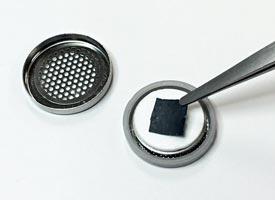

02/29/2016

© 2016 WILEY-VCH Verlag GmbH & Co. KGaA, Weinheim
By converting flat graphene sheets into three-dimensional (3D) architectures, AIMR researchers have developed a lightweight, metal-free electrode for lithium–oxygen (Li–O2) batteries that may have a transformative effect on all-electric vehicles1.
The excess weight and moderate capacities of today’s lithium-ion batteries have prompted a search for alternative technologies. Rechargeable lithium–oxygen batteries are a promising substitute because of their ultrahigh theoretical energy densities and ability to generate power by ‘breathing’ in oxygen from the atmosphere, negating the need for typical battery components.
These experimental batteries generally use a form of charcoal known as activated carbon as cathodes, and mix them with transition-metal catalysts. Activated carbon, however, becomes unstable under typical lithium–oxygen operating conditions ― after several charge–discharge cycles, the carbon begins to decompose battery electrolytes, causing premature device failure.
Another approach is to use two-dimensional graphene lattices as lithium–oxygen cathodes because of their high surface area, good chemical and mechanical stability, and high electrical conductivity. But integrating graphene into electrochemical cells is problematic: graphene connects poorly with metal electrodes and catalysts and is geometrically difficult to pack into cells with sufficient density.
Mingwei Chen and Jiuhui Han of the AIMR and co-workers have recently developed a way to coax graphene out of its planar geometry by growing it on the nanoporous surfaces of disposable nickel templates (see earlier highlight). This produces 3D materials with abundant pore space for trapping molecules, and the same high-speed electron mobility as their flat counterparts. In their latest work, the researchers teamed up with colleague Tadafumi Adschiri to investigate 3D graphene as a potential electrode for lithium–oxygen batteries.
One advantage of nanoporous graphene is that bending the flat lattice into 3D shapes introduces defects that can host dopants — small guest atoms that alter the surface chemistry of the larger carbon framework. The team studied nitrogen- and sulfur-doped 3D graphene because these atoms can promote lithium–oxygen reactions without metal catalysts.
The researchers fabricated centimeter-scale, flexible graphene electrodes and placed them into ‘coin-cell’ type lithium–oxygen batteries (see image) that snap together without the need for complex assembly or binding agents. Electrochemical tests revealed the benefits of these electrodes — the nitrogen-doped nanoporous graphene had a discharge capacity two orders of magnitudes greater than that of commercial lithium batteries and could be reliably recharged for hundreds of cycles.
“These excellent performances surpass state-of-the-art metal-free, graphene-based lithium–oxygen batteries,” says Han. “With such large capacities, they could transform portable electronics and power electric vehicles for extended ranges of more than 500 kilometers.”
Han, J., Guo, X., Ito, Y., Liu, P., Hojo, D., Aida, T., Hirata, A., Fujita, T., Adschiri, T., Zhou, H. & Chen, M. Effect of chemical doping on cathodic performance of bicontinuous nanoporous graphene for Li-O2 batteries. Advanced Energy Materials 6, 1501870 (2016). | article
This research highlight has been approved by the authors of the original article and all information and data contained within has been provided by said authors.